
Text © Prof. Pietro Pavone

English translation by Mario Beltramini
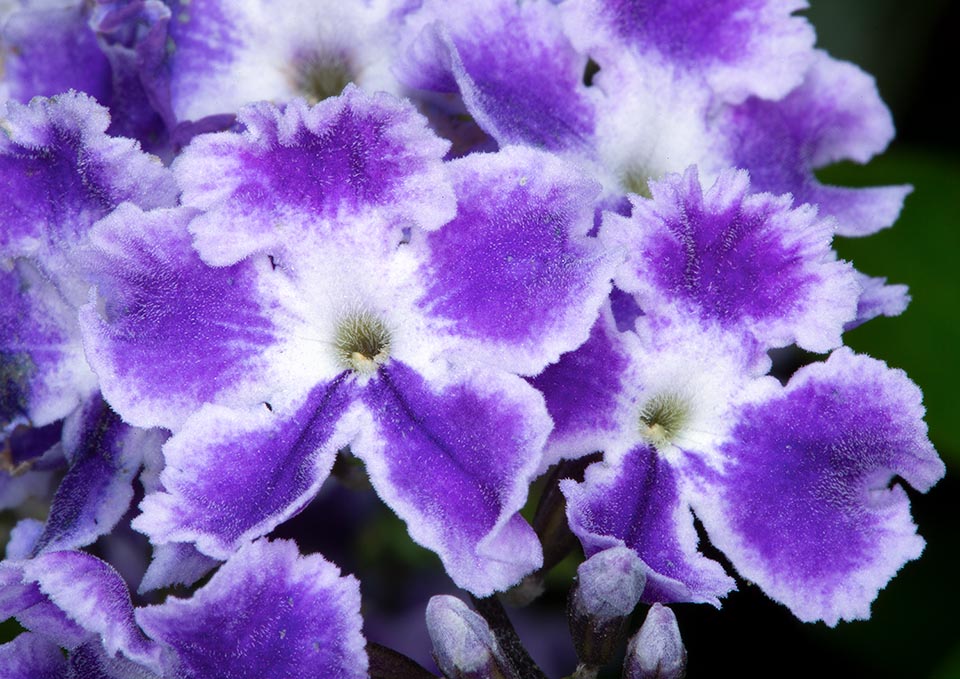
Enlarged Duranta erecta flowers. Very ornamental, is a verbena family plant frequent in the gardens, but in some areas, disseminated by birds, can become infestant © Giuseppe Mazza
The name of the family has been given, in 1805, by the French botanist and naturalist Jean Henri Jaume Saint-Hilaire (1772-1845). It comes from the genus Verbena L., 1753, that, in its turn comes from the Latin “herbena” = verdant, used to indicate the “verbenaca”, plant corresponding to the Verbena officinalis L.
It is a family of Dicotyledon plants of the order of the Lamiales that, following the classification APG (Angiosperm Phylogeny Group), regroups about 35 genera and more than 850 species of the temperate and tropical regions mainly of the New World, with some species in Europe, Asia, Africa and Madagascar.

Durante erecta flowers and fruits. In this species is not rare to find them together © Giuseppe Mazza
They are small trees, at times climbing shrubs, rarely grasses. The stems and the branches are often quadrangular, thorny at times.
The leaves are opposite or rarely spiralled, having no stipules, with simple or ternate laminae, palmiform at times. The laminae can be lanceolate or ovate, with toothed or lobed margin. In some species also thorny leaves are present.
The inflorescences are terminal or axillary, mainly of racemose type, formed by cylindrical spikes with erect posture, or panicles.
The flowers are slightly zygomorphic, rarely actinomorphic, tetracyclic (with 4 verticils) and pentamerous, (each verticil being formed by 5 parts), bisexual or unisexual due to reduction or abortion. The calyx is persistent, and the corolla, gamopetalous, is 4-5 lobed. The stamens are inserted on the tube of the corolla, and have no filaments, some transformed in one or more staminodes, the fertile ones have mono- or bi-locular anthers and release the pollen through longitudinal fissures or at time through a pore. The ovary is superior, plurilocular with 2-8 loculi, and each one with one or two ovules. The style is simple and the stigma is bilobed.
The pollination takes place by means of insects, but also, in the tropical areas of central and southern America, of hummingbirds.
The fruits are fleshy drupes, but also dry or sub fleshy schizocarps that when ripe separate in fout indehiscent mericarps, with one seed each.
The dispersion of the seeds may occur through animals, such as ants or birds, as well as through the wind.
From a systematic point of view, the family Verbenaceae is under continuous reprocessing, especially for what concerns its relationship with the family Lamiaceae.
After the recent molecular studies, the family is subdivided in eight clades, almost all monophyletic, and recognized as tribes: Casselieae, Citharexyleae, Duranteae, Lantaneae, Neospartoneae, Petreeae, Priveae and Verbeneae. The number of the species is shown in brackets.
The tribe Casselieae Tronc. regroups 3 genera and 20 species: Casselia Ness & Mart. (11), Parodianthus Tronc. (2) and Tamonea Aubl. (7). They are herbaceous plants or small shrubs with axillary composite inflorescences and flowers without staminodes.
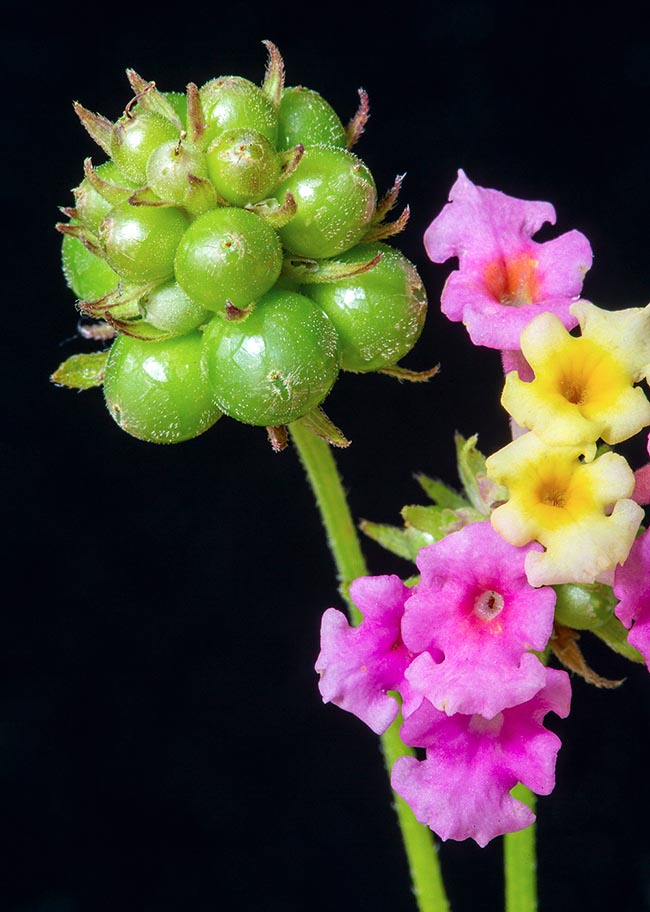
Verbenaceae make fleshy drupes or dry fruits that when ripe open in four indehiscent parts. The drupes of Lantana camara, here green close to the changing flowers, become dark violet when completely ripe © Giuseppe Mazza
The tribe Citharexyleae Briq. is formed by 3 genera with 134 species: Citharexylum Briq. is characterized by trees and shrubs diffused in the tropical areas of Central and South America; Rehdera Moldenke (3) with three species of Central America and Baillonia Bocq. (1) of Brazil and Paraguay.
They have racemose axillary inflorescences. The flowers are pedunculated with truncate or minutely toothed. The ovary is bicarpellate and the fruits are fleshy (drupes), formed by 2 or 4 seeds or less due abortion. In some species it is possible to have schizocarps dividing in 1 or 2 separate mericarps in two locules with 2 seeds.
The tribe Duranteae Benth. is subdivided in two clades, that is in two groups including the common ancestor and all its descendants phylogenetically very similar between them (sister groups).
One clade includes the genera Duranta L. (31/39) and Recordia Moldenke (2).
The genus Duranta is native to southern Florida, Mexico and southern America and later on has been diffused by man in the rest of the world. Its species are shrubs and small trees, often thorny, having linear floral bract, ovary formed by four carpels (this character is unique in the family) with eight ovules, fleshy fruits (drupes), globose stigma (capiate) and one staminode. They are ornamental plants for embellishing gardens, however, in some areas, they have got away from the cultivations behaving as infestants. This is the case of Duranta erecta L., that, thanks to the birds eating its fruits, has greatly diffused invading the Australian natural reserves and therefore considered as dangerous, to be eliminated with physical, chemical and biological means.
The genus Recordia Moldenke has only two species: R. reitzii (Moldenke) Thode & O’Leary, endemic to Brazil, and R. boliviana Moldenke, endemic to Bolivia. These are trees having flowers with linear bracts, ovary formed by two carpels, capitate stigma, four fertile stamens and one staminode, dry fruits (schizocarps).
The other clade regroups the genera: Stachytarpheta Vahl (134/142), Bouchea Cham. (19) with American species (i.e. Stachytarpheta jamaicensis (L.) Vahl ), naturalized in Australia, Africa, tropical Asia and India, and Chascanum E. Mey. (38) with species present in Africa, Madagascar, Arabia and India. This clade, unlike its twin, presents dry fruits (schizocarps) deriving from a monocarpellary, being the other carpel aborted, with two mericarps when ripe. The staminodes are absent, but Stachytarpheta Vahl that has two of them.
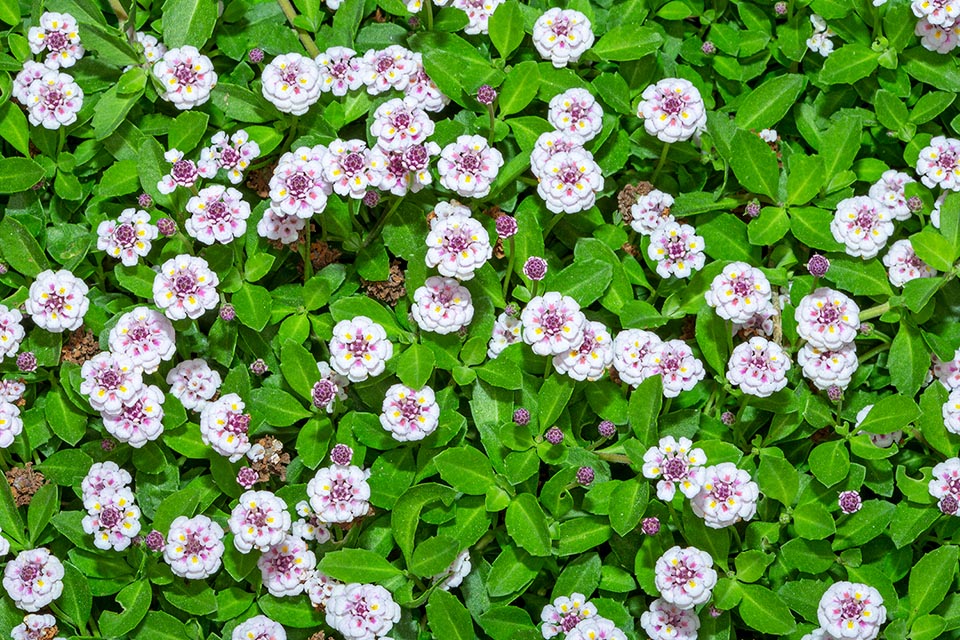
Phyla nodiflora is a verbenacea growing as cover of the soil. Numerous very ornamental tiny inflorescences with violet hues in the centre © Giuseppe Mazza
The inflorescences are spikes, subtended by leafy branches that can be interpreted as homologous to the composite racemes of Duranta. It is believed that the tribe Duranteae is the second group (after the tribe Petreeae) having had its own independent evolution inside the family with an estimated age of about 40 million years. Hence, Duranteae is sister group of the other groups of the family Verbenaceae.
The tribe Lantaneae Endl. is formed by 8 genera: Acantholippia Griseb. (7), Aloysia Paláu (47), Coelocarpum Balf.f. (8), Lantana L. (133-156), Lippia L. (194-214), Nashia Millsp. (7), Phyla Lour. (13), Xeroaloysia Tronc. (1). This tribe could have originated in the Miocene (23-5 million years ago) in the American continent from Mexico to all southern America, then, with a long range dispersion, its descendants could have migrated to northern America and Africa.
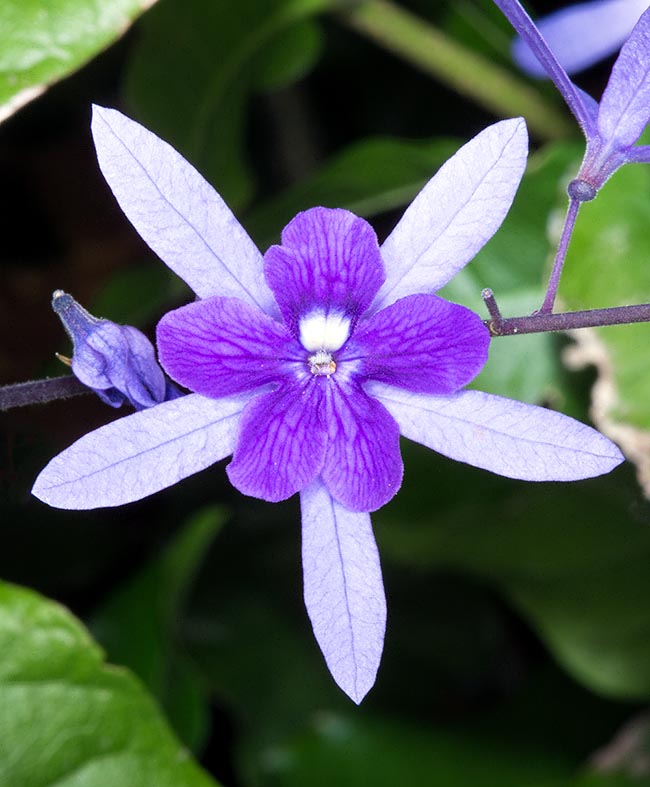
Petrea volubilis. The calyx has 5 pale petaloid lobes that persist even after the fall of the violet corolla © G. Mazza
In recent times, some genera (Lantana, Phyla, Lippia) have been diffused by the man and in some areas, such as Australia, have naturalized. The monophyly of the tribe, due to the complexity of the morphological traits between the membres and in absence of sufficient molecular data, is not certain.
The species of this tribe have usually a shrubby posture, at times sarmentose, able to climb, at times they can form herbaceous pillows (Phyla).
Lippia reaches the 4-10 cm of height, has green to blue-green leaves, oval, with jagged edges and, from May to September, scented white-pinkish inflorescences that attract bees and butterflies. The leaves, usually opposite, but alternate in Acantholippia, have the lamina toothed in the edge and don’t have petiole.
In Aloysia they can be petiolate and even glandular-resinous. The inflorescences are axillary in racemes (i.e. Aloysia gratissima (Gillies & Hook.) Tronc.), corymbs, racemose spikes, drooping or erect. The flowers, usually, are sessile or shortly pedunculate, hermaphroditic with tubular calyx and little lobate, normally persistent on the fruit.
The corolla is gamopetalous, usually actinomorphic, zygomorphic in Coelocarpum and Lippia, and having tubular shape and quadri- or pentalobate, variously coloured. The branches and somewhat spinescent and the flowers, white or perfumed, are arranged in dense axillary racemes, 2-3 cm long but at times even 5 cm. The androecium is composed of four fertile stamens, included and adherent to the corolla. A nectariferous disk is present around the ovary, that is superior and monocarpellar (due to abortion of the second one). The ovules are two per each carpel, the carpels are two with 4 ovules in Coelocarpum. The fruits can be drupes or schizocarps that, when ripe, do separate in two mericarps containing one seed each.
The tribe Neospartoneae includes the genera: Diostea Miers. (1) of Argentina and Chile, Lampayo Phill. ex Murillo (3) of Bolivia, Chile and Argentina, Neosparton Griseb. (4) of the arid regions of Argentina. The inflorescences are terminal, (lateral in some species of Neosparton), formed by sessile flowers with tubular corolla much longer than the calyx. In Diostea and Neosparton a staminode is present. The ovary is monocarpellary and the fruit is a schizocarp. In Diostea and Neosparton the stems are cylindrical and photosynthetic, resembling the stems of Ephedra, with reduced and ephemeral leaves. Lampayo includes shrubby species with fleshy leaves.
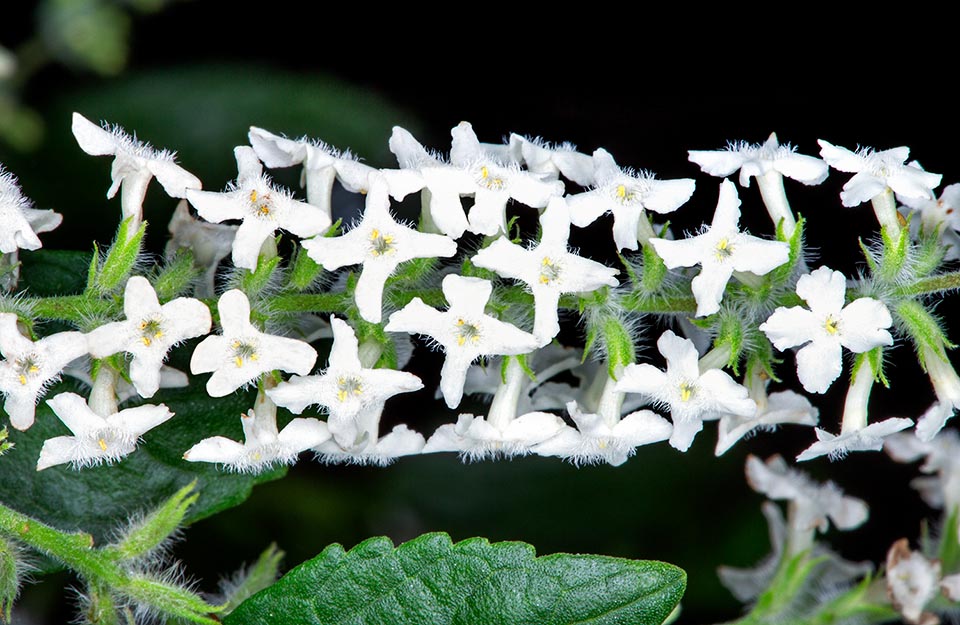
Aloysia gratissima tiny flowers open in spring-summer and emit an intense vanilla scent © Giuseppe Mazza
The tribe Petreeae Briq. is formed by two genera: Petrea L. (11) of Central America, present in tropical habitats and Xolocotzia of Mexico and of Honduras. They are climbing sarmentose shrubs or small trees. They have fleshy fruits and sepals longer than the corollas. In Petrea volubilis L. the most eye-catching part of the flower is the calyx with its 5 petaloid lobes of pale violet colour that persists also after the fall of the corolla that is dark violet. In the phylogenetic structure of the family, the tribe is the first group having evolved inside the family. It occupies, in fact, the “basal” place and therefore can be considered as sister group of the other membres of the family. It is thought that the separation occurred about 42 million years ago.
The tribe Priveae includes 2 genera: Pitraea Turcz. (1) of South America and Priva Adans. (20) of the tropical areas of South Africa , Asia and subtropical and tropical areas from south-western USA up to northern Argentina. They are perennial herbaceous plants. Pitraea is the only genus in the family of perennial herbaceous plants with tubers. Priva has species woody at the base. The tribe is characterized by flowers with short corolla, not too more than the calyx, toothed foliar margins and, in several species, hooked hairs on the stem and in the petioles of the leaves. The ovary is bicarpellary superior. The fruit is one schizocarp that when ripe divides in two mericarps having two seeds.
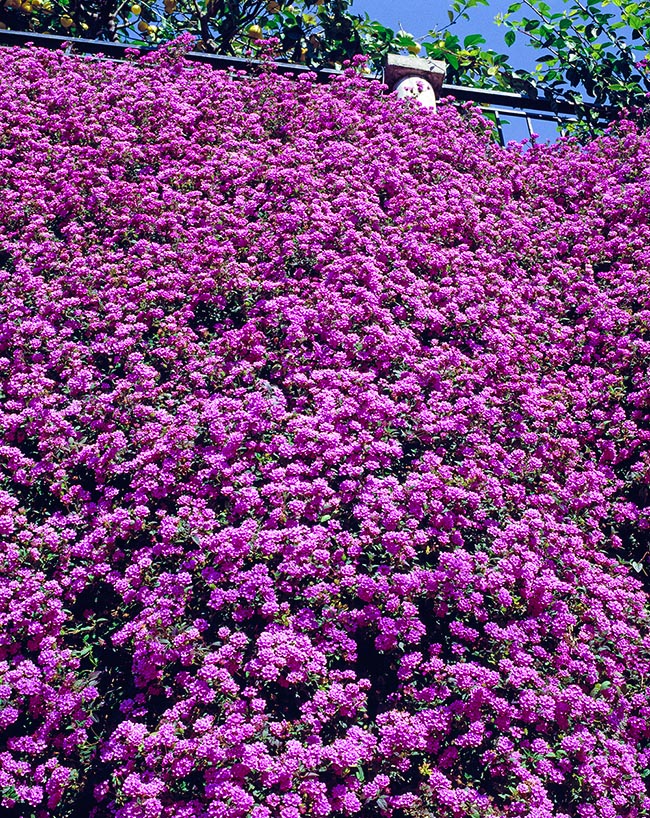
Lantana montevidensis is a low growing plant with thin stems, often creeping, here cultivated in a hanging position from the garden of a Mediterranean villa. A cascade of mauve pink or violet flowers with yellow-whitish throat © Giuseppe Mazza
The tribe Verbeneae Dumort. includes 6 genera: Glandularia J.F. Gmel. (84) of America; Hierobotana Briq. (1) Ecuador; Junellia Moldenke (37) Peru, Chile, Patagonia; Mulguraea N.O Leary & P. Peralta (11) Argentina; Urbania Phil. (1) of northern Chile and of north-western Argentina; Verbena L. (44) America, Europe, Asia. The tribe includes herbaceous species (annual or perennial), shrubby, climbing Glandularia). Some are woody at the base or procumbent (Hierobotana), others, thorny. They have white, pink, blue or violet corolla. The fruits are schizocarps, that, when ripe, divide in four mericarps (with one seed each). These plants are not aromatic.
Incertae sedis
Two genera (Dipyrena Hook. and Rhaphithamnus Miers), presently do not have a collocation in any one of the eight tribes of the family.
From a phylogenetic point of view, Dipyrena is close to the group Lantaneae-Verbeneae, whilst Rhaphithamnus is located between the tribes Neospartoneae and Priveae.
Studies on the phylogenesis of the family suggest that the species ascribed to it did originate in the late Cretaceous (65 million years ago) in the tropical pluvial forests of South America, from where they have migrated, with the time, widening their range from Patagonia to Canada and then moved from the sea level up to the highlands of the Andes, adapting to the different habitat conditions.
Some of them, through a trans-oceanic dispersion, did colonize Eurasia (Verbena officinalis), even if, probably, in relatively more recent times. Another dispersion has occurred from South America to Africa where some species belonging to the genera Lantana, Lippia and Priva are present.
A genus exclusive to the Old World (Africa, Arabia, Indian subcontinent), is Chascanum that can be considered as a strict next of kin of Bouchea of South America. The genus Coelocarpum of Madagascar can be considered as “sister group” of the rest of the Lantaneae and therefore this dispersion is older than that of the genera Lantana and Lippia, even if the tribe Lantaneae is relatively recent (Miocene, about 23 million years ago) inside the Verbenaceae. This dispersion has been done from West to East and this has been rendered possible by the animals (i.e. birds), or by the wind, but, at the current state of our knowledge, we do not know which one of the two vectors has covered the most important rôle.
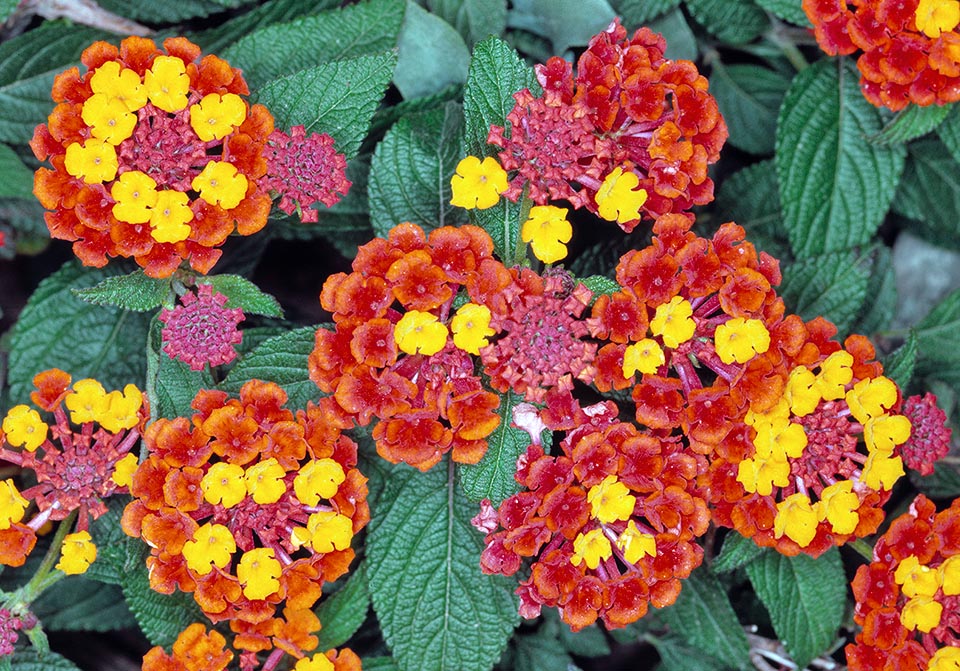
Pollen must not be wasted. So, after the fecundation, the yellow flowers of Lantana camara become red, to show to the thrips, attracted only by yellow, the remaining ones © Giuseppe Mazza
The family Verbenaceae includes various species having their own medicinal properties. The Lantana trifolia L. is traditionally used as an anti-inflammatory medicinal plant in Venezuela. Specific studies, utilizing methanolic extract of the aerial parts of the plant on laboratory animals, have confirmed the anti-inflammatory and antipyretic properties of the popular medicine.
Lippia alba (Mill.) N.E.Br. ex Britton & P.Wilson is a medicinal plant known and utilized in Colombia for the fast relief it determines in many gastrointestinal disorders. Watery extracts in vitro of leaves of this plant have proven an antibacterial activity in regard to isolated cultures of Helicobacter pylori. The essential oil, the extracts, watery and alcoholic, obtained from the plant have antibacterial, antiviral, antiparasitic and antimycotic powers.
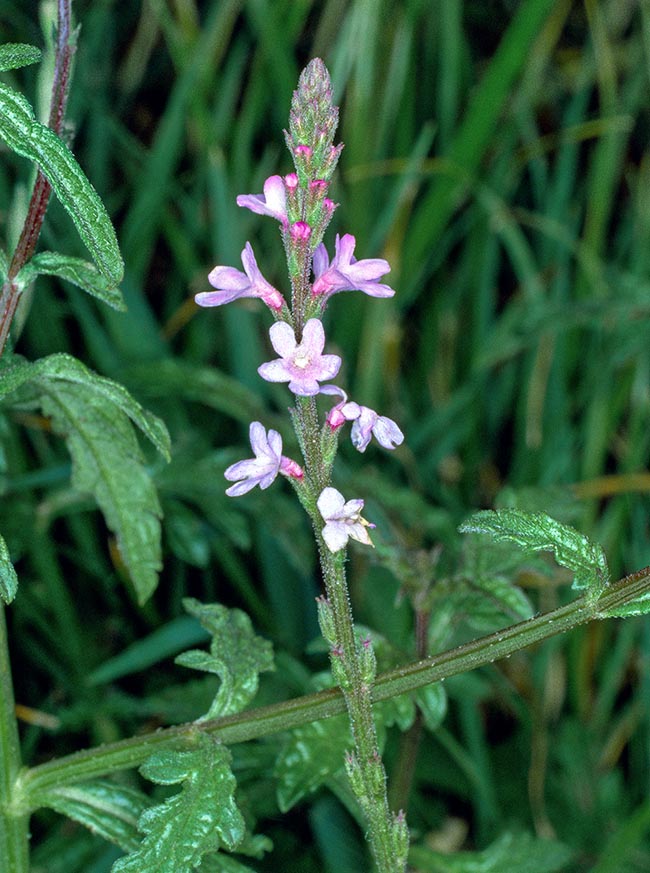
Verbena officinalis has digestive virtues and, in high dosages, emetic. In the popular medicine the plant is employed for treating the sore throat, the asthma, the whooping cough, the cold, the pain in the chest, but also to treat the depression, the hysteria, the arthritis, the gout and to heal wounds and burns © Giuseppe Mazza
Phyla nodiflora (L.) Greene has anti-inflammatory properties and is utilized to treat pain in the knee joints, intestinal pains, ulcers and boils.
In its extracts have been found carbohydrates, flavonoids, phenols, sterols, and, in the essential oil, two significant bioactive compounds, halleridone and hallerone, having antitumoral, antimalarial, antifungal property. Duranta erecta L. is employed as repellent for insects and for treating the malarial fever.
In Bangladeshy popular medicine, Lantana camara is used as antimalarial. As a matter of fact, the oleanolic acid, isolated from the plant, has antibacterial, and antifungal properties that justify its use for treating tuberculosis, malaria, and the pain generated by various causes including the rheumatoid arthritis. It has also been evidenced that the verbascoside, isolated from the extract of lantana, holds antimicrobial, immunosuppressive and antitumor activity. The use of lantana oil is suggested also for treating itching skin and as antiseptic for wounds, leprosy and scabies.
The Verbena officinalis has stimulating digestive properties and, at high dosages, emetic. In the popular medicine the plant is employed for treating sore throat, asthma, whooping cough and colds, chest pain, gallbladder, but also for treating depression, the hysteria, arthritis, gout and for healing wounds and burns.
The extract of the leaves, the roots and of the whole plant of Stachytarpheta jamaicensis (L.) Vahl is utilized in many countries as tonic, emetic, expectorant, sudorific, purgative, emmenagogue, emollient and refresher. It is also amply utilized in treating dysentery. In Peninsular Malaysia, they drink a decoction of leaves for the nasal ulcers. In Java, the decoction of the root is utilized for the gonorrhea and as abortive. In Indochina, the crushed leaves are rubbed on the body as febrifuge. In Western Africa, extracts of the leaves are used for treating ophthalmia and are applied to the sores of the ears of the children.
The Brazilian Ministry of Health has developed during the last decades an ample program of phytotherapy with the aim of providing access to the natural medicines for the entire population. One of the species utilized for this program is Lippia sidoides Cham., included in the Formulário de Fitoterápicos da Farmacopéia Brasileira due to its strong antimicrobial activity due to the presence in the essential oil, of terpenoids having activity against Candida albicans, Staphylococcus aureus and Escherichia coli.
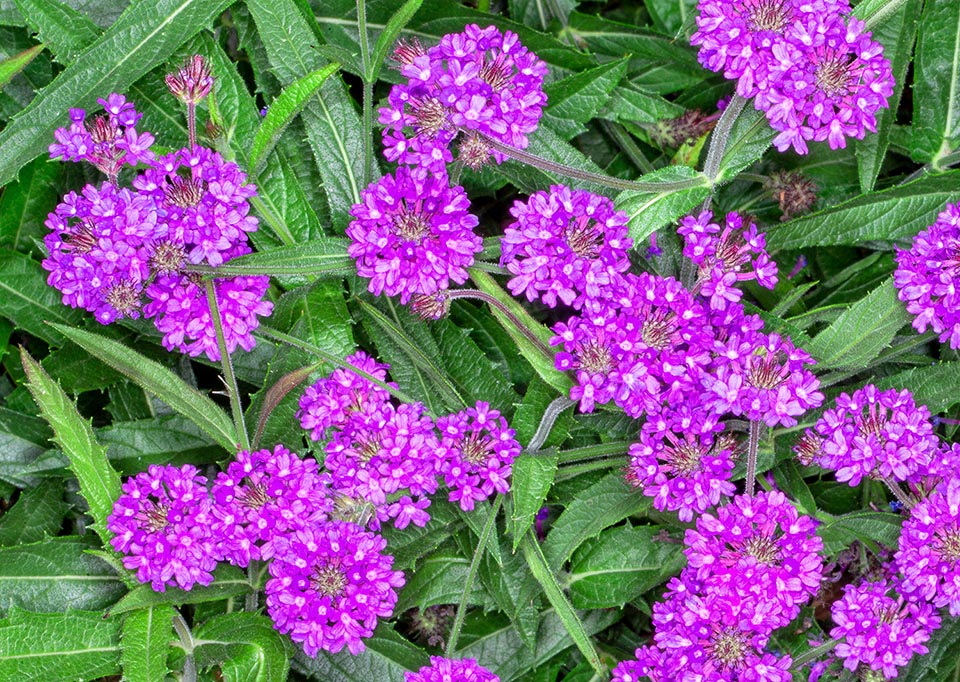
Verbena rigid is a cespitose herbaceous plant with a compact look. Due to the rich inflorescences is often used as soil cover © Giuseppe Mazza
The terpenoids, produced by the plant for its own defense, can be considered as a promising source of biological compounds. Various essential oils, such as linalool, eugenol, carvone, vanillin, carvacrol and thymol have been accepted by the European Commission for their utilization in the food preservation or in the aromas.
Some species of the family Verbenaceae are also valuable ornamental plants thanks to their showy flowers, Verbena hybrida Groenl. & Rumpler, is frequently utilized as a bedding plant. Glandularia canadensis (L.) Small, having large flowers, and
Verbena bipinnatifida Nutt., with small ones, are often cultivated in the gardens. Also Duranta erecta L. is cultivated for its blue or intense violet flowers in clusters open almost all the year round, and for its yellow or orange flowers. Aloysia citriodora Palau is a shrub that may reach 3 m of height, characteristic for the leaves, deciduous, lanceolate, of pale green colour, that emit an intense citrus scent. Lantana camara L. is utilized in the gardens for ornament as well as for keeping mosquitoes away.
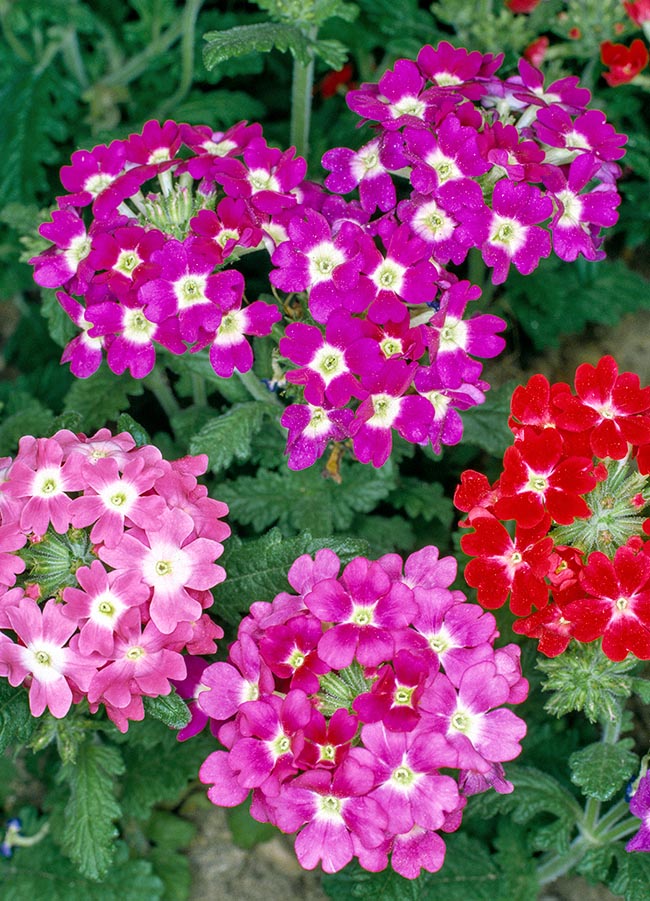
Verbena hybrida is actually a species presenting with variously coloured flowers. It is often used in flower beds © Giuseppe Mazza
Lantana montevidensis (Spreng.) Briq. has the same characteristics as the Lantana camara but is suitable to be utilized as ground cover. Also, Phyla nodiflora (L.) Greene is a cover, resistant to frost and heat, excellent for the realization of flowered lawns from June to October without any mowing necessity. Petraea volubilis is a splendid climbing plant that donates spectacular bloomings from spring to summer but can be cultivated in open air only in the sites with a very mild climate, whilst in the rigid climate regions may be cultivated in pots to be placed in protected locations during the winter.
Verbena rigida Spreng. is a cespitose herbaceous plant, with cauline tubers having axillary buds that will originate new plants. The stem is quadrangular, and the sessile leaves with short internodes, therefore the appearance of the plant is compact and is suitable to be employed as covering. In winter, in the rigid climates, the leaves dry up but from the base of the plants, in spring, a new vegetation will originate. Like all tuberous plants, it is a very invasive plant and can escape the gardens.
Verbena officinalis is a plant suitable for the cultivation in pots and in the balconies. Prefers sunny locations.
Glandularia peruviana (L.) Small is a creeping herbaceous plant with stretched stems and flowers of intense red colour grouped in inflorescences at the extremities of the stems that stretch considerably when ripe. It is used for flower beds and borders.
Phyla nodiflora is cultivated as a covering plant and is quite ornamental thanks to the inflorescences that are violet in the centre with around many tiny flowers of colour varying from white to pink.
Citharexylum spinosum L. is an elegant deciduous or evergreen tree with perfumed flowers cultivated in the gardens and in the green areas. In its origin places, South Florida, Caribbean, Guyana, Suriname and Venezuela, it is a plant utilized for the wood, that is of good quality, and for fabricating very good musical instruments.
Genera: Acantholippia, Aloysia, Baillonia, Bouchea, Casselia, Chascanum, Citharexylum, Coelocarpum, Dipyrena, Duranta, Hierobotana, Junellia, Lampayo, Lantana, Lippia, Mulguraea, Nashia, Neosparton, Parodianthus, Petrea, Phyla, Pitraea, Priva, Recordia, Rehdera, Rhaphithamnus, Stachytarpheta, Tamonea, Urbania, Verbena, Xeroaloysia, Xolocotzia.
→ To appreciate the biodiversity within VERBENACEAE family please click here.
